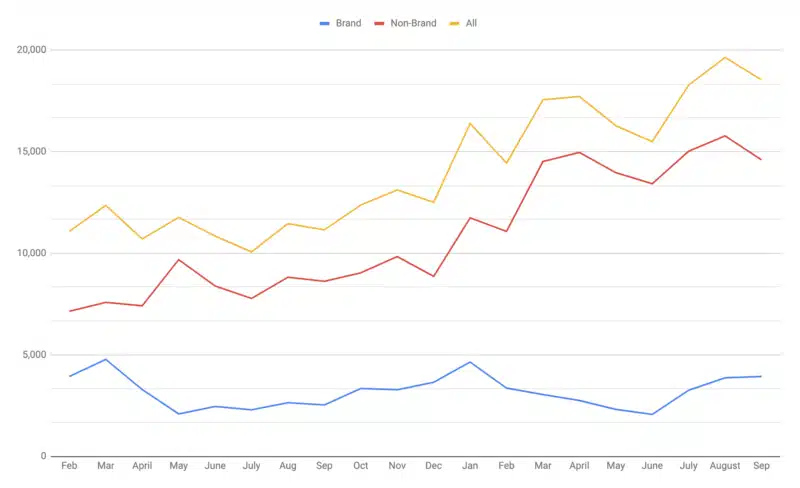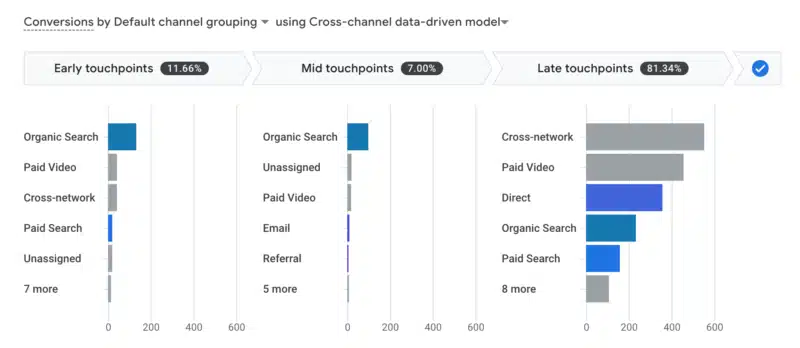4 advanced ways you’re not measuring SEO effectiveness – yet
Measure SEO impact beyond basic traffic and keyword ranking. Learn how your efforts are driving actual business outcomes with these metrics.
In 4 smarter ways to measure SEO effectiveness, I analyzed four fairly boilerplate SEO metrics (traffic, rankings, conversions, links) and detailed ways to apply an additional layer of rigor to each to improve your analytical insights.
In this article, I’m going to take it up a notch to introduce four new methods of gauging the value of your SEO campaigns. They are:
- Brand vs. non-brand clicks.
- SEO’s impact on other channels.
- SEO CAC (customer acquisition cost).
- SEO keyword performance (we’re bringing it back!).
While some of these are more directional than others, I’ve found each to be a highly effective way of quantifying the impact of my team’s SEO efforts for our clients. (If you’re in-house, they play well with executives looking to gauge your team’s value.)
1. Brand vs. non-brand clicks
Why is this segmentation important? A couple of reasons.
First, brand traffic indicates a level of awareness and intent that means these users aren’t net-new.
They may have become aware of your brand through earlier SEO searches, but you won’t have a chance to connect those dots without segmenting the data.
There’s obviously value in brand traffic, particularly when you start getting traffic on {brand + product} or {brand + service} queries.
But the exact value may differ from bringing net-new users into your system, particularly if you’re using first-touch attribution.
The other reason is that in certain industries (particularly SaaS), a decent chunk of brand traffic comes from customers using Google to find your site so they can log back in. This absolutely affects the aggregate value of brand searches.
All that said, I use Google Search Console to get insight into brand vs. non-brand searches.
You could use Ahrefs or Semrush to do the same thing, but I prefer GSC (although the UI isn’t as snazzy) because all the data is coming directly from Google.
Even though it’s only a data sample, I contend that it’s more accurate than third-party tools, and the best organic measurement tries to reduce ambiguity as much as possible.
Of course, because it’s just giving you a sample, GSC isn’t perfect, and I’m clear with my clients about that.
When we’re all on the same page about it being the best option for measuring brand vs. non-brand traffic, I:
- Export the keyword data (a subset of the total traffic) from GSC within a date range.
- Remove/filter any keywords that mention the brand.
- Calculate the percentage of non-brand vs. brand keyword data.
Here’s what that looks like:

Once you have several months’ worth of this data, you get a good layer of visibility into exact non-brand and brand trends.
2. SEO’s impact on other channels
While SEO can obviously lead directly to conversions (as I’ll discuss more in a minute), much of its value comes from up-funnel engagements.
It’s extremely common for good SEO campaigns to introduce users to – and educate them about – brands and products/services, only to have users convert on other, more transaction-focused channels.
So what’s the value of those engagements?
How do we measure SEO’s impact on downstream metrics?
On a macro level, one of the things I look at over time is whether there’s any correlation between increased SEO traffic and lower customer acquisition cost (CAC) on other channels.
If SEO engagement is growing a lot, and performance marketing is becoming more efficient, that’s a signal to dig into your traffic mix and close/sales mix to see exactly:
- Where leads are coming from.
- Which channels are bringing in leads with a good close rate.
One of the most promising features of GA4, which I’ve been playing with a ton recently, is that once you set up events/conversions, there’s an attribution model that shows multi-touch attribution so you can get a direct measurement of touchpoints in a conversion channel.
That’s a huge boost to a more nuanced measurement of SEO’s value if you’re tying back engagements to conversions. The report looks like this:

To round out the picture with less scientific, more quantifiable data, make sure your sales reps are asking leads where or how they’ve heard of you.
You can get good data and insight into how SEO is related to other channels – whether you’re at an enterprise company with scale that shows you macro trends or you’re at an SMB where one SEO-related conversion can really change the performance picture.
3. SEO customer acquisition cost
One of my favorite metrics to calculate is SEO customer acquisition cost (CAC).
I’ve heard fairly frequently over the years that SEO fees are high – especially in times of disruption. But if you can put the ROI of SEO in front of the people holding the budgets, you’ll likely be in good shape.
First, pick a set-up (GA4, Looker, Mixpanel, etc.) that enables you to track engagements.
Choose an attribution model and create a channel report to track signups, leads, demo requests, etc. (or product views, add to carts, conversions, etc. if you’re in ecommerce).
Ultimately, you’re looking to ascribe a raw number of events with attributed value back to your SEO campaigns.
Next, look at your SEO costs per month. These generally boil down to agency fees and/or in-house resources, plus any tech stack costs.
Apply those costs to find how much you pay to get these users (and events).
For example, if you pay a full-service SEO agency $10,000 a month to run SEO and write content, and the SEO channel delivered 200 last-click signups in that month, you could report a simplified $50 CAC for SEO.
With metrics like that, odds are you’ll be able to show a great return on spend that you can line up against CPC from paid channels.
Additionally, you can compare this CAC number to an LTV data point to really see the value.
If the LTV of your customer is greater than the SEO CAC, you are moving in the right direction for showing SEO as a profitable marketing channel.
You don’t need to re-invent reporting for SEO, but compare apples to apples if parties are using performance data as a comparison.
4. SEO keyword performance
SEO long-timers will remember with fondness the days before 2011 when Google started replacing valuable keyword-level data with “keyword not provided.”
It’s a lot harder to pinpoint and quantify exact keyword performance and value, but you can put together some pieces to get close.
Understanding the play between SEO and paid search is really crucial and helps address the question of how to ascribe sign-ups to specific keywords if all you can do is find traffic in GSC.
Paid search provides accurate, to-the-minute keyword data.
If you’re targeting the same keywords in both paid and organic search, you can take the rough conversion percentage from paid search and extrapolate the value of organic engagement.
Even if you’re not able to access paid search data, there are scenarios where you can ascribe value.
Let’s say you build a “program features” page for a SaaS product that’s ranking on page one for a long-tail non-brand term.
You can look at how people are converting on that page (GA4, Looker, Mixpanel) and triangulate how that keyword is doing.
So if 80% of that traffic on the page is from the long-tail keyword (which you can find in GSC), you can say there’s a high likelihood that they’re converting from that keyword.
Are these methods exact? No.
Are they directionally useful? Yes.
Conclusion
GA4 advancements aside, SEO measurement is an exercise in imperfection.
That doesn’t mean you should settle for the basic units of measurement you can get from Google or third-party platforms.
Be clear with the powers that be about how you’re getting your numbers and that they’re directional, not 100% accurate.
Flex your analytical muscles to dig a little deeper to understand how your efforts are driving actual business outcomes.
Measuring SEO impact beyond basic traffic and keyword ranking is hard.
This is why real SEO business insight is so valuable in helping execs and decision-makers gauge its standing in the marketing mix.
Opinions expressed in this article are those of the guest author and not necessarily Search Engine Land. Staff authors are listed here.
Related stories
New on Search Engine Land